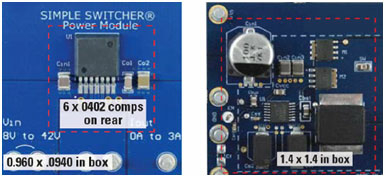source: EDN article
Rajan Bedi -September 27, 2017
Previously, I compared space-grade isolated DC-DCs and switching POLs, which resulted in lots of interesting discussion between us. With so much emphasis on cost, I was recently asked by a customer to recommend discrete power transistors, op amps, transformers, inductors, and capacitors to allow the client to make bespoke voltage regulators.
As an example, the synchronous, voltage-controlled buck regulator shown below comprises two FETs, an inductor, a capacitor, several resistors, a reference, and op-amps to realise an error amplifier and PWM comparator within the feedback control loop.

Figure 1 Synchronous, voltage-controlled buck regulator
Previously, I described in detail the operation of buck and boost converters and the principles of energy transfer: for any switching regulator, intrinsic component imperfections generate dc conduction losses which impact efficiency resulting in power dissipation, e.g. the FET has a finite drain-to-source resistance, RDS(ON), and the inductor has winding resistance, RDCR, both of which produce small voltage drops.
The parasitic gate capacitance of the power FET, CGD, has to be continually charged and discharged resulting in timing losses. The inductor also has an ac magnetic core loss, PSW_CORE, which increases as a function of frequency.
The value of the inductor is important and high inductance results in lower ripple current, less core losses, smaller rms currents in the switches and lower capacitance to meet the desired ripple specification. A low inductance results in less DCR, higher saturation currents, faster switching frequencies, and better transient responses.
Low-ESR ceramic capacitors reduce input and output ripple while larger bulk capacitances determine the overall transient response. The inductor and output capacitor form a second-order low-pass filter and the impedance of the latter impacts the stability of the feedback control loop.
In addition to the obvious power/current/voltage/thermal compliance rating of components, the tendency to move to higher switching frequencies to avail of smaller regulators, faster transient responses, and smaller voltage over/undershoots, places even greater demands on the specifications of the discrete parts. While switching regulators process dc line and load voltages, their internal operation is switching large currents at MHz speeds and the use of shielded magnetics minimise EMI.
The selection of the components is very application specific, they all contain parasitics and I explain the criteria to select discrete parts in my power course. Today, there are approximately 10 suppliers of space-grade FETs, eight providers of qualified op amps, five vendors of Hi-Rel inductors, and eight manufacturers of space-grade capacitors. Depending on the fabrication technology and the mission’s radiation requirements, some low-cost, COTS FETs can also be considered for the switch and the transistor, which replaces the freewheeling diode. The specifications for both differ.
As a second example, the voltage-controlled linear regulator shown below comprises an NPN bipolar pass transistor, an output bypass capacitor, two feedback resistors, an op-amp, and a reference to provide regulation.

Figure 2 Voltage-controlled linear regulator
Depending on the application, i.e. input voltage, dropout, ground current, noise, and PSRR, more efficient and cleaner component options may exist, e.g. the use of a PNP transistor or a PMOS FET for the pass element.
Different capacitor options are available each with specific temperature and voltage behaviours. Low ESR minimises ripple and affects the stability of the feedback control loop.
Today, there are approximately 10 suppliers of space-grade BJTs and six providers of qualified references. Depending on the fabrication technology and the mission’s radiation requirements, some low-cost COTS parts can also be considered for the pass transistor, e.g. SiGe.
While an integrated POL offers advantages in PCB footprint, lower parasitics, and a smaller BOM, some OEMs prefer or have to make their own regulators. The arguments for making vs. buying are equally valid. Proprietary designs realised using discrete components have been operating successfully in-orbit for many years.
As an example, modular and discrete COTS buck regulators (Vin=+24 V, Vout=+3.3 V and Iload = 3 A) are shown below: the former has integrated the inductor while the latter contains an IC controller. Both designs contain 10 parts with the BOM for the discrete implementation costing $4.14. The modular one has a price of $10.19 and is approximately one-third smaller.

Figure 3 Modular vs. discrete buck regulators
The cost and area differentials are more extreme for space-grade equivalents and I compare a number of qualified integrated vs. discrete designs, and show you how to successfully design space-grade and COTS-based isolated DC-DCs and POLs in my power course. I also reveal and compare all the suppliers of qualified integrated regulators as well as providers of discrete components to help to you make reliable, low-cost, bespoke, space-grade DC-DCs/POLs.
Rajan Bedi is CEO of Spacechips Ltd, which provides industrial R&D and space electronics design consultancy services to manufacturers of satellites and spacecraft around the world.































